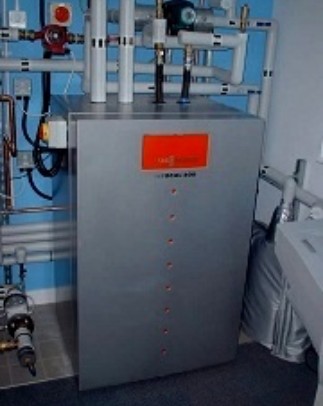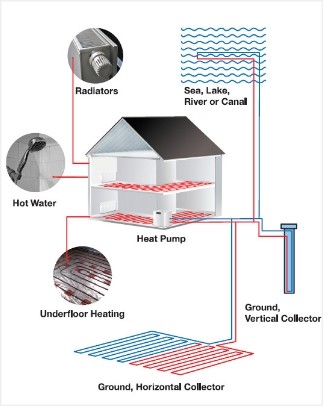Domestic GSHPs
With more and more of us looking to heat our homes in a more eco-friendly manner and save on the costs of doing so, many people are now switching to heat pumps for their domestic requirements.

How does a GSHP work?
A Ground Source Heat Pump transfers heat from the ground into buildings.
Radiation from the sun heats the earth. The earth then stores the heat and maintains, just two metres or so down, a temperature of around 10°C even throughout the winter. A ground source heat pump uses a ground heat exchange loop to tap into this constantly replenished heat store to heat buildings and provide hot water. The technology used is the same as that used in refrigerators. Just as a fridge extracts heat from the food and transfers it into the kitchen, so a ground source heat pump extracts heat from the earth and transfers it into a building.
How efficient are Ground Source Heat Pumps?
For every unit of electricity used by the heat pump, three to four units of heat are captured and transferred. In effect this means a well installed Ground Source Heat Pump can be 300-400% efficient in terms of its use of electricity. At this efficiency level there will be 70% lower carbon dioxide emissions than for a gas boiler heating system. If the electricity is provided by renewable energy, then carbon emissions can be reduced to zero.


What do they look like?
A Ground Source Heat Pump system comprises three basic elements – a ground heat exchange loop, the heat pump itself which concentrates available heat from the ground, and a heat distribution system.
The ground loop is a pipe buried underground in a horizontal trench or a vertical borehole. Horizontal trenches are dug two metres below ground level and, although needing more land area than a borehole, they are usually cheaper for smaller systems.
Boreholes are drilled to a depth of 15 to 150 metres and may benefit from higher ground temperatures than trenches. There are a variety of types of pipe which can be used in a trench instead of a straight one, which increase the amount of heat absorbed from the ground and so enhance performance. The ground area required for trenches will vary with the location, the property and the heat output required. As a general guide, for a newly built 3-bedroomed house of around 120 m2 with a heat loss of around 6kW, two trenches of 30-40 metres in length would typically be required.
A water/anti-freeze mixture is circulated through the pipe where it absorbs heat from the ground. A heat exchanger then extracts the absorbed heat and transfers it to the heat pump. The third basic element of a ground source heat pump, the heat distribution system, can be either low temperature radiators or underfloor heating. If the heat pump is asked to produce higher temperatures, for a conventional radiator circuit, then its efficiency will reduce.
If the location has access to an aquifer, as is often the case in the South East of England, an alternative to a closed ground heat exchange loop is to drill two open
loop boreholes to absorb heat directly from the aquifer.
Once a ground source heat pump is installed, there are no external fans and no external equipment is visible. The system is quiet in operation, issues no emissions, is very safe and requires very little maintenance.
Installation Costs
The installation costs will depend on the site and the amount of heat output required. A site survey is necessary to determine which type of collector (horizontal
trenches, vertical borehole, water-source or open-loop) is most appropriate. As an indicative guide, the installed cost of a horizontal GSHP system is likely to be in the range £1,250 – £1,750 per kW of capacity, with that for a vertical borehole closed-loop system in the range £1,750 – £3,000 per kW. However, the cost will be specific to the type of property and technical approach required. The Renewable Heat Incentive is a major financial encouragement to install ground source heat pumps: Ofgem will pay 20.46 pence per kWhr of eligible heat generated every year for seven years – for heat pumps installed and commissioned by 31 March 2022. From April 2022 the RHI will be replaced by a simpler Heat Pump Grant of £6000 called the “Boiler Upgrade Scheme”.
GSHPs can be installed anywhere in the UK, using a borehole or shallow trenches or, less commonly, by extracting heat from a pond or lake. Heat collecting pipes in a closed loop, containing water (with a little antifreeze) are used to extract this stored energy, which can then be used to provide space heating and domestic hot water. Heat pumps can also be reversed in summer to provide cooling.
Ground source heat pumps have been widely used in North America, Sweden, Germany and Switzerland for many years. Typically they cost more to install than
conventional heating systems. However, they have very low maintenance costs and can be expected to provide safe, reliable and emission-free heating for well over 20 years, with the ground loop lasting at least 100 years.
Running Costs
The running costs of a well designed ground source heat pump system are lower than for any other space heating system, whether fossil fuel based or renewable. Savings in running costs of 30% to 70% can be achieved depending on the type and price of fuel being displaced.
The only energy used by a ground source heat pump that you pay for is electricity to power the compressor and the circulation pumps which transfer heat energy from the ground into the building. A well designed ground source heat pump installation will deliver three or four times as much thermal energy (heat) as is used in electrical energy to drive the system. For a particularly environmental solution, green electricity can be purchased.
Ground source heat pumps work best with heating systems which are optimised to run at a lower water delivery temperature than is commonly used in traditional radiator systems. As such, they make an ideal partner for underfloor heating or “oversized” radiators. However, as may gas-based systems were installed with generous radiator sizing there may be no need to enhanced existing installtions on installing a heat pump.
The Advantages of Ground Source Heat Pumps
Ground Source Heat Pumps save money. Heat pumps are much cheaper to run than direct electric heating systems. GSHPs are cheaper to run than oil boilers, burning coal, LPG or gas. This is before taking into account the receipt of RHI, which amounts to over £3,000 a year for an average four bedroom detached house – larger than for any other technology under the RHI.
- Fully Automated
Because heat pumps can be fully automated they demand much less work than
biomass boilers. - Heat pumps save space.
There are no fuel storage requirements. - No need to manage fuel deliveries
- No risk of fuel being stolen
- Heat pumps are safe
There is no combustion involved and no emission of potentially dangerous gases.
No flues are required. - GSHPs require less maintenance than combustion based heating systems
They also have a longer life than combustion boilers. The ground heat exchanger
element of a ground source heat pump installation has a design life of over 100 years. - Heat pumps save carbon emissions
Unlike burning oil, gas, LPG or biomass, a heat pump produces no carbon emissions on site (and no carbon emissions at all, if a renewable source of electricity is used to power them). - GSHPs are safe, silent, unobtrusive and out-of-sight
They require no planning permission. Heat pumps can also provide cooling in summer, as well as heating in winter.
Ground source heat pumps are the only renewable energy technology that can benefit from the thermal energy storage properties of the ground to recycle heat from summer to winter. A well designed ground source heat pump system is likely to increase the sale value of your property.

Become a Member
The GSHP Association is the focal point for business interests in the ground source heat pump industry.
We represent the ground source heating & cooling industry, promoting sustainable use of heat pump technology and engaging with government and other bodies to influence relevant policymaking on behalf of our members.

